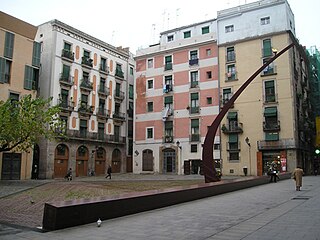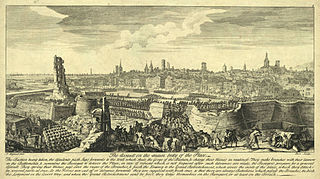
The Treaty of the Pyrenees was signed on 7 November 1659 on Pheasant Island, and ended the Franco-Spanish War that had begun in 1635.

The Principality of Catalonia was a medieval and early modern state in the northeastern Iberian Peninsula. During most of its history it was in dynastic union with the Kingdom of Aragon, constituting together the Crown of Aragon. Between the 13th and the 18th centuries, it was bordered by the Kingdom of Aragon to the west, the Kingdom of Valencia to the south, the Kingdom of France and the feudal lordship of Andorra to the north and by the Mediterranean Sea to the east. The term Principality of Catalonia remained in use until the Second Spanish Republic, when its use declined because of its historical relation to the monarchy. Today, the term Principat (Principality) is used primarily to refer to the autonomous community of Catalonia in Spain, as distinct from the other Catalan Countries, and usually including the historical region of Roussillon in Southern France.

The Reapers' War, also known as the Catalan Revolt, was a conflict that affected a large part of the Principality of Catalonia between the years of 1640 and 1659. It had an enduring effect in the Treaty of the Pyrenees (1659), which ceded the County of Roussillon and the northern half of the County of Cerdanya to France, splitting these northern Catalan territories off from the Principality of Catalonia and the Crown of Aragon, and thereby receding the borders of Spain to the Pyrenees.

The Fossar de les Moreres is a memorial square in Barcelona, adjacent to the basilica of Santa Maria del Mar. The plaza was built over a cemetery where defenders of the city were buried following the Siege of Barcelona at the end of the War of the Spanish Succession in 1714. The plaza features a memorial to the fallen Catalans of the war, with a torch of eternal flame and a heroic poem by Frederic Soler, "El Fossar de les Moreres".

The siege of Barcelona was a thirteen month battle at the end of the War of Spanish Succession, which pitted Archduke Charles of Austria against Philip V of Spain, backed by France in a contest for the Spanish crown.

The third siege of Girona occurred in northern Catalonia, Spain from 6 May to 12 December 1809, during the Napoleonic Wars. A significant event of the Peninsular War, France's Grande Armée lay siege to the town of Girona for seven months. Girona was strategically important because it controlled the main road between France and Spain.

Prince George Louis of Hessen-Darmstadt was a Field Marshal in the Austrian army. He is known for his career in Habsburg Spain, as Viceroy of Catalonia (1698–1701), head of the Austrian army in the War of the Spanish Succession (1701–1705) and governor of Gibraltar in 1704. He was killed during the Siege of Barcelona the following year. He was known in Spanish as Jorge de Darmstadt and in Catalan as Jordi Darmstadt.

Rafael Casanova i Comes was a Catalan jurist and supporter of Charles VI, Holy Roman Emperor as a claimant to the Crown of Spain during the War of the Spanish succession. He became mayor of Barcelona and commander in chief of Catalonia during the Siege of Barcelona until he was wounded in combat while commanding La Coronela during the counterattack on the Saint Peter front on the last day of the siege, 11 September 1714. After the war he received a royal pardon for having supported the Habsburg claim to the Spanish throne. He recovered from his wounds, and continued his fight against absolute monarchy as a lawyer. It has been claimed that he is the author of the book Record de l'Aliança fet el Sereníssim Jordi Augusto Rey de la Gran Bretanya in which Catalonia reminds England of the Treaty of Genoa and their obligation to Catalonia.

The siege of Barcelona of 1697 was successfully conducted during the Nine Years' War by France. Louis Joseph, Duke of Vendôme, commanding some 32,000 troops, forced the garrison, under Prince George of Hesse-Darmstadt, to capitulate on 10 August. Nevertheless, it had been a hard fought contest: according to John Lynn, French casualties totalled around 9,000, while the losses on the Spanish side were 12,000 killed, wounded, or lost, although Antonio Espino López has set the figure for Spanish losses at 4,500 killed and 800 wounded, and the French casualties at 15,000, including 52 engineers.

The Blockade of Barcelona from August to December 1808 during the Peninsular War, was the failed attempt by Spanish troops to recapture the French occupied Barcelona.

The siege of Barcelona took place between 14 September and 19 October 1705 during the War of the Spanish Succession when a multinational Grand Alliance army led by Lord Peterborough, supporting the Habsburg pretender to the Spanish throne, captured the city of Barcelona from its Spanish Bourbonic defenders, most of whom then joined the Habsburg army.

The siege of Barcelona took place between 3 and 27 April 1706 during the War of the Spanish Succession when a Franco-Spanish army laid siege to Barcelona in an attempt to recapture the city following its fall to an English-led Allied army the previous year.

The Naval battle of Barcelona was a naval engagement of the Franco-Habsburg War fought off Barcelona from 29 June to 3 July 1642 between a Spanish fleet commanded by Juan Alonso Idiáquez, Duke of Ciudad Real, and a French fleet under Jean Armand de Maillé-Brézé, Duc de Fronsac.
In a three-day battle, Brézé defeated the Spanish fleet, which was attempting to relieve some Spanish garrisons isolated along the Catalan coast, and forced the Duke of Ciudad Real to retreat to Majorca for repairs. As usual in most of the battles involving Maillé-Brézé, the French fleet made an extensive use of her fireships. This time, however, a large French vice-flagship, the Galion de Guise, fell victim to one of his own fireships and went down enveloped in flames. The victory, in any case, was for the French fleet, and its main long-term effect was the fall of Perpignan into the hands of the Franco-Catalan army.

The Revolt of the Barretines also known as the Revolt of the Gorretes, was a Catalan rebellion fought against the government of King Charles II of Spain. The most salient complaint was against the government's quartering of soldiers. Other issues of contention were tax protests and Catalan nationalistic tensions. The revolt was funded and intensified by agents of France as part of the War of the Grand Alliance. Civil disorder lasted from 1687 to 1689.

The Corpus de Sang was a riot which took place in Sant Andreu de Palomar and later in Barcelona on 7-10 June 1640, during Corpus Christi, which marked a turning point in the development of the Reapers' War.

The 2010 Catalan autonomy protest was a demonstration in central Barcelona on 10 July 2010 against limitations of the autonomy of Catalonia, and particularly against a recent decision of the Spanish Constitutional Court to annul or reinterpret several articles of the 2006 Statute of Autonomy of Catalonia. The number of people taking part in the demonstration was estimated at between 1.1 million and 1.5 million, while Madrid-based newspaper El País estimated the number of demonstrators at 425,000. The mobilisation was described as "unprecedented" by the mayor of Barcelona. The Barcelona daily newspaper El Periódico de Catalunya described it as "without a doubt one of the biggest protest marches that has ever occurred in Catalonia, possibly the biggest". It is thought that the 2012 Catalan independence demonstration involved more people, but this protest brought the dispute to light in the world.

Montjuïc Castle is an old military fortress, with roots dating back from 1640, built on top of Montjuïc hill in Barcelona, Catalonia, Spain. It currently serves as a Barcelona municipal facility.

The Barcelona of 1842 was a keg of social conflict. Amongst the issues was the free trade policy of the regent General Espartero and the damage it was causing to the textile industry and the livelihood of workers. Another simmering issue was the tax required to be paid for bringing food into the city. A climate of permanent tension existed in the city that foreshadowed an eventual explosion of violence.

The Catalan Republic was a short-lived independent state under French protection proclaimed in 1641 by the States-General of Catalonia led by Pau Claris, during the Reapers' War.

The Capture of the galleon Lion Couronné was a naval engagement that took place off Formentera on 17 June 1651, during the Franco-Spanish War (1635–1659). A squadron of eleven Spanish galleys under John of Austria the Younger captured the French galleon Lion Couronné after a fight.



















